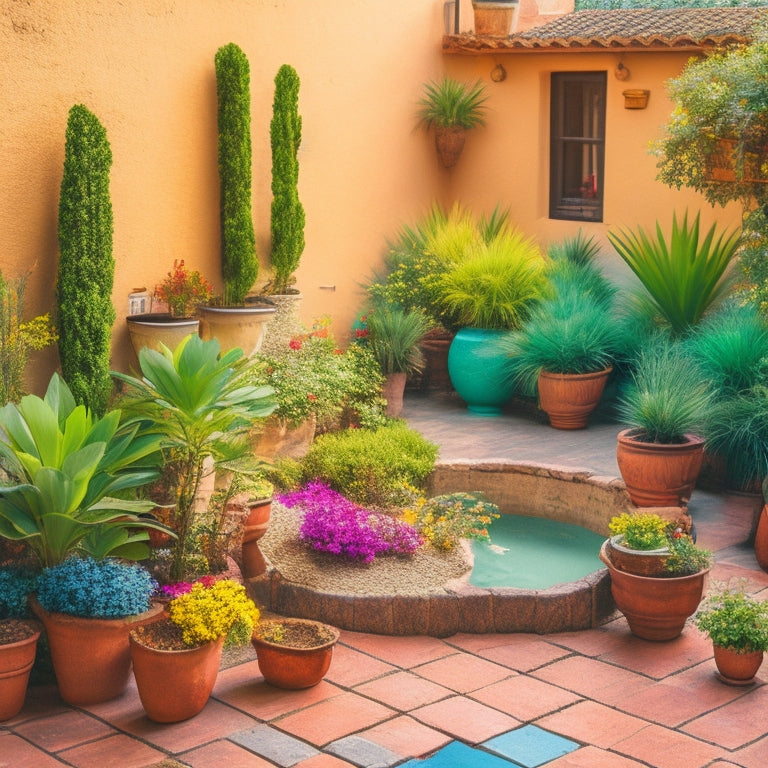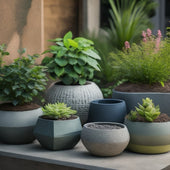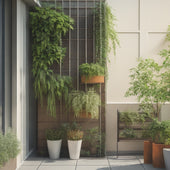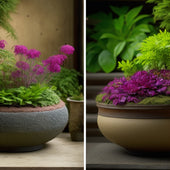
Thriving Rooftop Gardens in Hot and Dry Climates
Share
You can create a flourishing rooftop garden in hot and arid climates by selecting plants adapted to these conditions, such as succulents and Mediterranean herbs. Use well-draining soil with adequate moisture retention and employ drip irrigation to reduce evaporation and runoff. Provide shade with structures like trellises or umbrellas, and opt for heat-tolerant plants. Choose high-temperature-resistant planters and UV-stabilized irrigation tubing to guarantee durability. Regularly maintain your garden by checking the irrigation system, pruning plants, and monitoring pests. Implement these strategies, and you'll be well on your way to a flourishing rooftop oasis - now, discover the nuances that'll take your garden to the next level.
Choosing the Right Plants
When choosing plants for your rooftop garden in a hot and dry climate, you'll need to focus on species that are adapted to thrive in conditions with intense sunlight, high temperatures, and limited water availability. Succulents and cacti are ideal choices, as they've evolved to store water in their leaves, stems, or roots, making them highly resistant to drought. Other excellent options include Mediterranean herbs like rosemary, thyme, and oregano, which are naturally adapted to dry conditions. These plants won't only survive but thrive in your rooftop garden, requiring minimal watering and maintenance.
When it comes to plant selection, understanding the specific microclimate of your rooftop garden is crucial. Take into consideration the amount of direct sunlight your garden receives, as well as any wind patterns or shading. This will assist you in choosing plants that are perfectly suited to the conditions, ensuring they'll flourish and require less water conservation efforts.
Soil and Irrigation Strategies
While selecting drought-resistant plants is a key aspect of rooftop gardening in hot and dry climates, you'll also need to focus on creating a soil and irrigation system that complements these plants' unique needs. A well-designed soil and irrigation system will help your plants thrive in the harsh conditions.
Here are some strategies to keep in mind:
-
Soil selection: Choose a soil mix that's well-draining, yet retains enough moisture to support your plants. A mix with a high organic matter content will help with water retention and aeration.
-
Drip irrigation: This method delivers water directly to the roots, reducing evaporation and runoff. It's especially effective in hot and dry climates where water is scarce.
-
Mulching benefits: Mulch helps retain moisture, suppress weeds, and regulate soil temperature. Organic mulch like wood chips or bark also adds nutrients to the soil as it breaks down.
-
Irrigation scheduling: Water your plants deeply but infrequently to encourage deep root growth. Avoid frequent shallow watering, which can lead to weak roots and increased water loss.
-
Soil monitoring: Regularly check your soil's moisture levels and adjust your irrigation schedule accordingly. This will guarantee your plants receive the right amount of water without wasting this precious resource.
Providing Adequate Shade
Your rooftop garden's success in hot and dry climates depends on providing adequate shade to protect your plants from intense sunlight and heat stress. Without proper shading, plants can suffer from scorched leaves, reduced growth, and increased water loss.
To combat this, consider installing shade structures such as trellises, pergolas, or umbrellas. These can be strategically placed to cast dappled shade or create a microclimate that reduces direct sunlight.
When selecting plants, opt for those with natural heat tolerance and low water requirements. Succulents, cacti, and drought-tolerant grasses are excellent choices. By combining shade structures with heat-tolerant plants, you'll create a water-conserving oasis that thrives in hot and dry conditions.
Additionally, consider using shade cloth or screens to filter intense sunlight and reduce evapotranspiration. By providing adequate shade, you'll create a rooftop garden that's not only beautiful but also resilient and sustainable.
Climate-Resilient Materials
Select materials for your rooftop garden that can withstand the harsh conditions of hot and dry climates, such as high-temperature-resistant planters, UV-stabilized irrigation tubing, and weathered wood or metal trellises that can endure intense sunlight and extreme temperature fluctuations. These climate-resilient materials will guarantee your garden remains healthy and thriving despite the challenging environment.
When choosing materials, consider the following essential elements for a sustainable design:
-
Robust planters: Made from materials like fiberglass, ceramic, or recycled plastic, these planters can withstand high temperatures and UV radiation.
-
Water-efficient irrigation systems: Install a drip irrigation system or soaker hose to conserve water and reduce evaporation.
-
Heat-resistant trellises: Opt for trellises made from weathered wood or metal that can withstand intense sunlight and heat.
-
UV-protective mulch: Apply a layer of organic mulch that can shield the soil from UV radiation and retain moisture.
-
Water-harvesting systems: Incorporate a rainwater harvesting system to collect and store rainwater for irrigation, reducing your reliance on municipal water supplies.
Maintenance and Upkeep Tips
Regularly check your rooftop garden's irrigation system to identify and fix leaks, clogs, and other issues that can result in water waste and plant damage. A well-kept system guarantees your plants receive the appropriate amount of water, especially in warm and arid climates.
Establish a watering schedule that considers factors like soil composition, plant varieties, and weather conditions. You'll also need to employ pruning techniques to support healthy growth, prevent overcrowding, and promote air circulation.
Keep a lookout for pests such as aphids, whiteflies, and spider mites, and utilize organic pest management methods whenever feasible. Fertilize your plants consistently using approaches like drip irrigation or compost tea to supply crucial nutrients. Monitor your plants' reaction to fertilization and modify your approaches as necessary.
Frequently Asked Questions
Can Rooftop Gardens Be Designed for Wheelchair Accessibility and Mobility?
You can create inclusive rooftop gardens by incorporating universal access and sustainable design principles, ensuring wheelchair mobility through ramps, wide pathways, and adaptable planters, while prioritizing garden design that promotes visual harmony and ecological balance.
How Do Rooftop Gardens Impact Property Value and Resale Appeal?
You'll boost property value and resale appeal by incorporating energy-efficient, aesthetically pleasing rooftop gardens, showcasing sustainability and marketability to potential buyers, who'll appreciate the unique selling point and increased curb appeal.
Are Rooftop Gardens a Good Habitat for Local Wildlife and Biodiversity?
As you create a rooftop oasis, you're coincidentally supporting local wildlife conservation and biodiversity! By providing habitat enhancement, you're fostering ecosystem benefits, offering a haven for species to thrive, and boosting the area's ecological richness.
Can Rooftop Gardens Be Used for Urban Agriculture and Food Production?
As you design your rooftop garden for urban agriculture, you'll need to contemplate water conservation through efficient irrigation techniques and crop selection tailored to seasonal planting, ensuring a thriving and productive harvest.
Do Rooftop Gardens Require Special Insurance Coverage or Liability Protection?
You'll need to secure specialized insurance coverage and liability protection for your rooftop garden, addressing rooftop safety concerns and risk management to shield yourself from potential lawsuits and financial losses.
Related Posts
-

5 Best DIY Planter Ideas to Upcycle Concrete
You're about to breathe new life into discarded concrete blocks by transforming them into functional and visually app...
-

5 Best DIY Planter Ideas to Upcycle Concrete
You're about to breathe new life into discarded concrete blocks by transforming them into functional and visually app...
-

5 Best DIY Planter Ideas to Upcycle Concrete
You're about to breathe new life into discarded concrete blocks by transforming them into functional and visually app...
-

5 Best DIY Planter Ideas to Upcycle Concrete
You're about to breathe new life into discarded concrete blocks by transforming them into functional and visually app...
-

5 Best DIY Planter Ideas to Upcycle Concrete
You're about to breathe new life into discarded concrete blocks by transforming them into functional and visually app...
-

5 Best DIY Planter Ideas to Upcycle Concrete
You're about to breathe new life into discarded concrete blocks by transforming them into functional and visually app...
-

5 Best DIY Planter Ideas to Upcycle Concrete
You're about to breathe new life into discarded concrete blocks by transforming them into functional and visually app...
-

5 Best DIY Planter Ideas to Upcycle Concrete
You're about to breathe new life into discarded concrete blocks by transforming them into functional and visually app...
-

5 Best DIY Planter Ideas to Upcycle Concrete
You're about to breathe new life into discarded concrete blocks by transforming them into functional and visually app...
-

5 Best DIY Planter Ideas to Upcycle Concrete
You're about to breathe new life into discarded concrete blocks by transforming them into functional and visually app...
-

5 Best DIY Planter Ideas to Upcycle Concrete
You're about to breathe new life into discarded concrete blocks by transforming them into functional and visually app...
-

5 Best DIY Planter Ideas to Upcycle Concrete
You're about to breathe new life into discarded concrete blocks by transforming them into functional and visually app...
-

5 Best DIY Planter Ideas to Upcycle Concrete
You're about to breathe new life into discarded concrete blocks by transforming them into functional and visually app...
-

5 Best DIY Planter Ideas to Upcycle Concrete
You're about to breathe new life into discarded concrete blocks by transforming them into functional and visually app...
-

5 Best DIY Planter Ideas to Upcycle Concrete
You're about to breathe new life into discarded concrete blocks by transforming them into functional and visually app...
-

5 Best DIY Planter Ideas to Upcycle Concrete
You're about to breathe new life into discarded concrete blocks by transforming them into functional and visually app...
-

5 Best DIY Planter Ideas to Upcycle Concrete
You're about to breathe new life into discarded concrete blocks by transforming them into functional and visually app...
-

5 Best DIY Planter Ideas to Upcycle Concrete
You're about to breathe new life into discarded concrete blocks by transforming them into functional and visually app...
-

3 Best Space-Saving Gardening Ideas for Urban Renters
You can turn even the smallest urban space into a lush oasis by utilizing clever space-saving gardening ideas. Maximi...
-

3 Best Space-Saving Gardening Ideas for Urban Renters
You can turn even the smallest urban space into a lush oasis by utilizing clever space-saving gardening ideas. Maximi...
-

3 Best Space-Saving Gardening Ideas for Urban Renters
You can turn even the smallest urban space into a lush oasis by utilizing clever space-saving gardening ideas. Maximi...
-

3 Best Space-Saving Gardening Ideas for Urban Renters
You can turn even the smallest urban space into a lush oasis by utilizing clever space-saving gardening ideas. Maximi...
-

3 Best Space-Saving Gardening Ideas for Urban Renters
You can turn even the smallest urban space into a lush oasis by utilizing clever space-saving gardening ideas. Maximi...
-

3 Best Space-Saving Gardening Ideas for Urban Renters
You can turn even the smallest urban space into a lush oasis by utilizing clever space-saving gardening ideas. Maximi...
-

3 Best Space-Saving Gardening Ideas for Urban Renters
You can turn even the smallest urban space into a lush oasis by utilizing clever space-saving gardening ideas. Maximi...
-

3 Best Space-Saving Gardening Ideas for Urban Renters
You can turn even the smallest urban space into a lush oasis by utilizing clever space-saving gardening ideas. Maximi...
-

3 Best Space-Saving Gardening Ideas for Urban Renters
You can turn even the smallest urban space into a lush oasis by utilizing clever space-saving gardening ideas. Maximi...
-

3 Best Space-Saving Gardening Ideas for Urban Renters
You can turn even the smallest urban space into a lush oasis by utilizing clever space-saving gardening ideas. Maximi...
-

3 Best Space-Saving Gardening Ideas for Urban Renters
You can turn even the smallest urban space into a lush oasis by utilizing clever space-saving gardening ideas. Maximi...
-

3 Best Space-Saving Gardening Ideas for Urban Renters
You can turn even the smallest urban space into a lush oasis by utilizing clever space-saving gardening ideas. Maximi...
-

3 Best Space-Saving Gardening Ideas for Urban Renters
You can turn even the smallest urban space into a lush oasis by utilizing clever space-saving gardening ideas. Maximi...
-

3 Best Space-Saving Gardening Ideas for Urban Renters
You can turn even the smallest urban space into a lush oasis by utilizing clever space-saving gardening ideas. Maximi...
-

What to Seal Your Planters With for Longevity
When sealing your planters for longevity, it's vital to choose a sealant compatible with your planter material - whet...
-

What to Seal Your Planters With for Longevity
When sealing your planters for longevity, it's vital to choose a sealant compatible with your planter material - whet...
-

What to Seal Your Planters With for Longevity
When sealing your planters for longevity, it's vital to choose a sealant compatible with your planter material - whet...
-

What to Seal Your Planters With for Longevity
When sealing your planters for longevity, it's vital to choose a sealant compatible with your planter material - whet...
-

What to Seal Your Planters With for Longevity
When sealing your planters for longevity, it's vital to choose a sealant compatible with your planter material - whet...
-

What to Seal Your Planters With for Longevity
When sealing your planters for longevity, it's vital to choose a sealant compatible with your planter material - whet...
-

What to Seal Your Planters With for Longevity
When sealing your planters for longevity, it's vital to choose a sealant compatible with your planter material - whet...
-

What to Seal Your Planters With for Longevity
When sealing your planters for longevity, it's vital to choose a sealant compatible with your planter material - whet...
-

What to Seal Your Planters With for Longevity
When sealing your planters for longevity, it's vital to choose a sealant compatible with your planter material - whet...
-

What to Seal Your Planters With for Longevity
When sealing your planters for longevity, it's vital to choose a sealant compatible with your planter material - whet...
-

What to Seal Your Planters With for Longevity
When sealing your planters for longevity, it's vital to choose a sealant compatible with your planter material - whet...
-

What to Seal Your Planters With for Longevity
When sealing your planters for longevity, it's vital to choose a sealant compatible with your planter material - whet...
-

What to Seal Your Planters With for Longevity
When sealing your planters for longevity, it's vital to choose a sealant compatible with your planter material - whet...
-

What to Seal Your Planters With for Longevity
When sealing your planters for longevity, it's vital to choose a sealant compatible with your planter material - whet...
-

What to Seal Your Planters With for Longevity
When sealing your planters for longevity, it's vital to choose a sealant compatible with your planter material - whet...
-

What to Seal Your Planters With for Longevity
When sealing your planters for longevity, it's vital to choose a sealant compatible with your planter material - whet...
-

What to Seal Your Planters With for Longevity
When sealing your planters for longevity, it's vital to choose a sealant compatible with your planter material - whet...
-

What to Seal Your Planters With for Longevity
When sealing your planters for longevity, it's vital to choose a sealant compatible with your planter material - whet...
-

What to Seal Your Planters With for Longevity
When sealing your planters for longevity, it's vital to choose a sealant compatible with your planter material - whet...
-

What to Seal Your Planters With for Longevity
When sealing your planters for longevity, it's vital to choose a sealant compatible with your planter material - whet...
-

What to Seal Your Planters With for Longevity
When sealing your planters for longevity, it's vital to choose a sealant compatible with your planter material - whet...
-

What to Seal Your Planters With for Longevity
When sealing your planters for longevity, it's vital to choose a sealant compatible with your planter material - whet...
-

What to Seal Your Planters With for Longevity
When sealing your planters for longevity, it's vital to choose a sealant compatible with your planter material - whet...
-

What to Seal Your Planters With for Longevity
When sealing your planters for longevity, it's vital to choose a sealant compatible with your planter material - whet...
-

What to Seal Your Planters With for Longevity
When sealing your planters for longevity, it's vital to choose a sealant compatible with your planter material - whet...
-

What to Seal Your Planters With for Longevity
When sealing your planters for longevity, it's vital to choose a sealant compatible with your planter material - whet...
-

What to Seal Your Planters With for Longevity
When sealing your planters for longevity, it's vital to choose a sealant compatible with your planter material - whet...
-

What to Seal Your Planters With for Longevity
When sealing your planters for longevity, it's vital to choose a sealant compatible with your planter material - whet...
-

What to Seal Your Planters With for Longevity
When sealing your planters for longevity, it's vital to choose a sealant compatible with your planter material - whet...
-

What to Seal Your Planters With for Longevity
When sealing your planters for longevity, it's vital to choose a sealant compatible with your planter material - whet...
-

What to Seal Your Planters With for Longevity
When sealing your planters for longevity, it's vital to choose a sealant compatible with your planter material - whet...
-

What to Seal Your Planters With for Longevity
When sealing your planters for longevity, it's vital to choose a sealant compatible with your planter material - whet...


